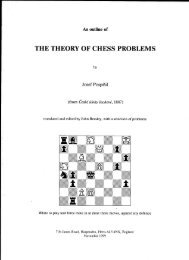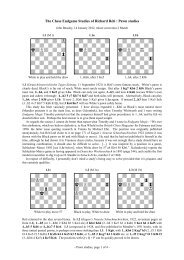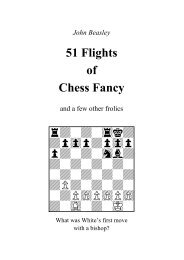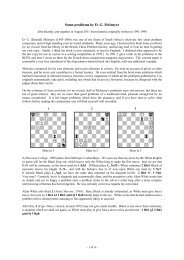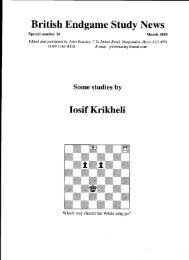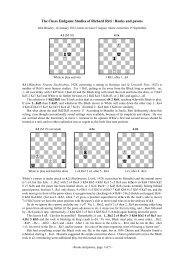A tribute to G. W. Chandler - John and Sue Beasley
A tribute to G. W. Chandler - John and Sue Beasley
A tribute to G. W. Chandler - John and Sue Beasley
Create successful ePaper yourself
Turn your PDF publications into a flip-book with our unique Google optimized e-Paper software.
<strong>Ch<strong>and</strong>ler</strong> <strong>and</strong> the “modern” chess problem 7<br />
certainly look <strong>to</strong> see whether apparently strong Black moves have set replies in the<br />
diagram, but he is interested in the moves which don’t have set replies <strong>and</strong> not in<br />
those which do. (Even if he does find some attractive set play, he is less likely <strong>to</strong><br />
be hypnotized by it than composers imagine; having found a Black move which<br />
needs attention, he will concentrate on providing for it or preventing it, <strong>and</strong> if this<br />
involves finding a new answer <strong>to</strong> a move <strong>to</strong> which there was a set reply he will<br />
shrug his shoulders <strong>and</strong> look for one.) If a lucky guess, “wouldn’t it be nice if,”<br />
hits on the key straight away, he will be pleased; if he spends a long time on a<br />
problem only <strong>to</strong> find that the key is a move so crude that he has been unwilling <strong>to</strong><br />
consider it, he will be disgusted. He takes no interest in “tries”, except perhaps <strong>to</strong><br />
see why an obviously tempting move or one apparently equivalent <strong>to</strong> the solution<br />
does not in fact work; this apart, he regards them simply as wrong moves, <strong>and</strong> his<br />
sole concern is <strong>to</strong> avoid wasting time on them. And he is not in the least interested<br />
in a change of play between try <strong>and</strong> solution. “A try is a move which doesn’t<br />
work,” he will say, “of course it leads <strong>to</strong> different play from one which does;<br />
what’s remarkable about that?”<br />
All this describes the kind of solver for whom <strong>Ch<strong>and</strong>ler</strong>, like every other<br />
traditional composer, produced his problems.<br />
The modern composer makes quite different dem<strong>and</strong>s. Listen <strong>to</strong> <strong>John</strong> Rice,<br />
who has been as staunch a defender of the modern viewpoint as <strong>Ch<strong>and</strong>ler</strong> was of<br />
the traditional, writing in his book Chess Wizardry (1996). After discussing the<br />
finding of the key <strong>and</strong> the variations, he continues:<br />
“The discovery of the key <strong>and</strong> the variation play will be sufficient for<br />
those taking part in solving championships <strong>to</strong> gain whatever points are on<br />
offer. But a full appreciation of a chess problem as a work of art dem<strong>and</strong>s<br />
more than this. If you find what you take <strong>to</strong> be the key after a few<br />
seconds’ search, don’t s<strong>to</strong>p there. Consider every variation, in itself <strong>and</strong><br />
in its relationship <strong>to</strong> other variations. You might be dealing with an example<br />
of reciprocal or cyclic play, where the pattern of defences or mates<br />
or both is all-important. Or you might even have been deceived by a try.<br />
Ideally, a try should be defeated by as obscure a refutation as possible.<br />
But sometimes a composer is forced <strong>to</strong> accept an obvious refutation<br />
simply because the move is inherent in the position. A try which introduces<br />
new play different from that found after the key should not be dismissed<br />
merely because it is obviously refuted. That try may well be an<br />
in-tegral part of the composer’s idea - half the problem, even. The<br />
solution <strong>to</strong> a direct-mate problem is not just White’s first move, but that<br />
<strong>and</strong> the variations it introduces, <strong>to</strong>gether with set play <strong>and</strong> any tries the<br />
position may contain <strong>and</strong> the play which they, in turn, introduce. The<br />
composer hopes that you will see his try or tries first <strong>and</strong> not discover his<br />
key until later, but this may not always be the case.” (Chess Wizardry, pp<br />
268-9.)<br />
The matter could hardly be put more clearly <strong>and</strong> comprehensively, <strong>and</strong> we see that<br />
some of the dem<strong>and</strong>s made by the modern composer on the solver are the exact<br />
opposite of traditional dem<strong>and</strong>s. The modern composer may require the solver <strong>to</strong>



